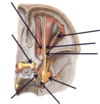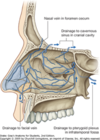HNS 2 Flashcards
What are the 3 main functions of the neck?
Structural: supports and moves the head
Visceral: contains the trachea and oesophagus
Conduit for blood vessels and nerves
Principle arterial supply of the head and neck?
Carotid arteries
What is fascia?
A connective tissue mainly composed of collagen fibres
Organises the body into different compartments
Why is the fascia clinically important?
Permits the spread of infection within compartments
What is the most external fascial layer in the neck and what does it contain?
Superficial fascia
Contains the platysma muscle at the front of the neck
Where on this diagram is the platysma muscle?

Anterior to the neck

What is the platysma innervated by?
Cervical branch of facial nerve
What are the 3 main compartments of the neck?

Visceral compartment
Vertebral compartment
Vascular compartment

What is deep to the superficial fascia?
Deep fascia
What layers are the deep fascia divided into?
Pretracheal fascia
Carotid sheath
Investing fascia
Prevertebral fascia
What does the pretracheal fascia surround?
Some of the visceral components of the neck
We can find some of the components of the digestive system and respiratory system + endocringe glands

Where is oesophagus in relation to trachea?
Oesophagus is posterior to the trachea
Which structures reside within the visceral compartments?
Oesophagus, trachea, pharynx + thyroid gland
What is deep fascia?
Dense, organised connective tissue deep to the superficial fascia
Organised into distinct layers:
- Carotid sheath
- Pretracheal fascia
- Investing fascia
- Prevertebral fascia
What is the carotid sheath and where is it on the diagram?

Fascia that surrounds the:
- common carotid artery
- internal jugular vein
- internal carotid artery
- vagus nerve

What does the investing layer of fascia contain?
- Sternocleidomastoid muscle
- Trapezius muscle
- Infrahyoid muscles
What structures are contained in the prevertebral layer + function?
- Spinal cord
- Deep muscles of the back
- Anterior, posterior + middle scalene muscles
Contains a number of muscles which help move + stabilise the ehad
What are the 2 main triangles of the neck?
Anterior triangle
Posterior triangle
What divides the 2 muscles of the neck + where does it go from and to?
Sternocleidomastoid muscle
From the skull down to the sternum + clavicle
What are the boundaries of the anterior triangle?
- Inferior margin of the mandible (superior)
- Anterior border of the sternocleidomastoid muscle (posterior)
Label diagram of the neck


Boundaries of the posterior triangle?
Posterior aspect of the sternocleidomastoid muscle
Anterior aspect = anterior aspect of the trapezius muscle
What muscles are contained in the anterior triangle of the neck?
Platysma muscle
Suprahyoid muscles (mylohyoid, geniohyoid, digastric + stylohyoid muscles)
Infrahyoid muscles (omohyoid, sternohyoid, thyrohyoid + sternothyroid muscle)
What blood vessels are contained in the anterior triangle of the neck?
Internal jugular vein
Common carotid artery
Internal carotid artery
Label the diagrams


Which cranial nerves pass through the anterior triangle of the neck?
Vagus nerve
Glossopharyngeal
Accessory
Hypoglossal
Facial nerve
What structures are mainly contained in posterior triangle of the neck?
Mainly blood vessels and nerve
What blood vessels and nerves are found in posterior neck?
External jugular vein
Subclavian artery
Subclavian vein
Trunks of brachial plexus
Phrenic nerve
Vagus nerve
Spinal accessory nerve
Which organ does the phrenic nerve supply?
Diaphragm
Where does the vagus nerve have functions?
Respiratory, cardiovascular + abdominal or GI tract
Label the diagram in posterior triangle


Label this diagram of nerves in the posterior triangle of the neck


Name cranial nerve XI and what muscles does it supply?
Accessory nerve
Sternocleidomastoid and trapezius muscle
Label the diagram of principal artery supply to the neck


What does the common carotid artery divide into?
External carotid and internal carotid
What does:
- external carotid artery
- internal carotid artery
- External carotid artery supplies the face
- Internal carotid artery goes into cranial cavity to supply brain
What are the principle branches of the external carotid artery?
- Superior thyroid
- Lingual
- Ascending pharyngeal
- Occipital
- Facial
- Posterior auricular (emerges behind the ear and supplies the skin on the back of the ear)
- Superficial temporal
- Maxillary (has a branch that goes into cranial cavity to support the meninges)
Which nerve innervates the posterior belly of the digastric muscle?
Facial nerve
Which vein is superficial to the sternocleidomastoid muscle?
External jugular vein
What do the muscles of facial expression do?
They can act to dilate or constrict the orifices of the face e.g. eyes and mouth
What groups can the muscles of facial expression be divided into and what are they innervated by?
Orbital, nasal and oral muscles
Innervated by cranial nerve 7 (facial nerve)
Label diagram of orbital muscles




What do the oral group of muscles act on?
Mouth and lips
What do auricular muscles move?
Move the ear
What nerve are the facial musles innervated by?
Cranial nerve number 7
Does the facial nerve innervate the parotid gland?
No
Why is the relationship between the facial nerve and the parotid gland clinically relevant?
surgery to remove the parotid gland, can also impact upon the function of the muscles of facial expression if damage to the cranial nerve occurs during surgery (facial nerve runs through parotid gland but doesn’t innervate it)
This can leave a patient with paralysis of the facial muscles on one side of the face
What are the branches of the facial nerve?
Zygomatic, buccal, mandibular, temporal and cervical branches
Label this diagram of the facial nerves


Joint between mandible and temporal bone?
Temporomandibular joint (TMJ)

Where do the ramus and inferior border of the mandible meet?
Angle of the mandible

What is the temporomandibular joint
Pair of joints connecting the mandible to the skull
Bilateral synovial articulation between the temporal bone and mandible, assisting in mastication
Muscles of mastication move the mandible
What part of the mandible forms the joint with the temporal bone?
Condylar process

What are the TMJ?
Temporomandibular joints are a pair of joints on the side of the head
Allow for opening and closing of the mouth for chewing (mastication)

What are the muscles of mastication innervated by?
Mandibular branch of the trigeminal nerve (CN5)
What does the movement of the TMJ depend on?
Dependent upon the level to which the mandible is open
What happens when the jaw is slightly open?
Hinge action predominates (opening + closing of mouth)
What happens when jaw is opened widely?
Hinge + gliding action occurs
What do movements of the mandible include?
Protrusion - jaw moves forwards
Retraction - jaw move backwards
Elevation - jaw moves upwards
Depression - jaw moves downwards
What muscle facilitates movements of the jaw (protrusion, retraction, elevation + depression)?
Facilitiated by the superficial muscles
What are the superficial muscles that facilitate movements of the jaws?
Temporalis muscle and masseter muscle
Where does temporalis muscle originate from?
Temporal fossa
Where does the temporalis muscle insert into?
Coronoid process of the mandible
What is the main function of the temporalis muscle?
Elevates + retraction of the mandible
Where do masseter muscles attach to?
The ramus and angle of the mandible
Where does masseter muscle originate from?
From the zygomatic arch
What does masseter muscle cause the jaw to do + when is it used for?
Causes elevation of the mandible + forced closure of mouth is required
What are the deeper muscles that move the mandible?
Lateral + medial pterygoid muscles
Label this diagram


Label this diagram


What is the lateral pterygoid muscle attached to and what process does it bring about?
Sphenoid bone, lateral pterygoid plate and neck of mandible
Depresses and protracts mandible to open the mouth
What is the medial pterygoid muscle attached to and what process does it bring about?
Lateral pterygoid plate, maxilla, palate and attached to the angle of the mandible
Bring about elevation, protraction and when used in isolation, brings about side to side movement for grinding
What are the orbits of the eye?
Bilateral structures which contain the eyeball, the muscles that move the eye, extraocular muscles, the optic nerve and other nerves and vessels
What is the roof of the orbit made of?
Orbital plate of the frontal bone
What is the floor of the orbit made up of?
Orbital plate of the maxilla
What is the medial wall of the orbit made up of?
Ethmoid and lacrimal bones
What is the lateral wall of the orbit made up of?
Lateral wall made up of the zygoma
What are the 3 main foramina of the orbit?
Optic canal
Superior orbital fissure
Inferior orbital fissure
Label this diagram containing the orbital foramina


What passes through the superior orbital fissure?
Opthalmic branch of trigeminal nerve (V1)
Oculomotor nerve (III)
Trochlear (IV)
Abducens (VI)
Opthalmic vessels
Sympathetic fibres
Where is the optic canal positioned in orbit?
More medially
What passes through the optic canal?
The optic nerve + opthalmic artery




































